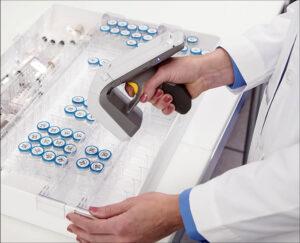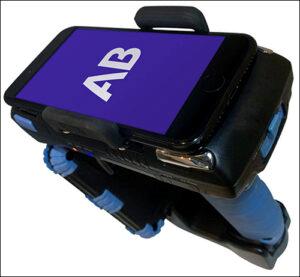Call Us Now
+8615914489090

Drug wholesaler AmerisourceBergen has released a Medication Tray Solution based on an app version to help hospitals manage drugs more easily.
The updated version of this solution is consistent with the RAIN Alliance standard adopted by the company to ensure that each UHF RFID tag has a standard-based unique ID number starting with a company identification number (CIN). These labels are generally applied to every product sent by
The RAIN Alliance recently launched a new ISO encoding system CIN to simplify the encoding of RFID tags and reduce the so-called tag confusion, that is, the messy reading of different tags used by different companies for different purposes. According to the president of the alliance, Steve Halliday (Steve Halliday), the alliance has been designated by ISO as a code issuer and can issue CINs.
AmerisourceBergen explained that the adoption of the RAIN standard can provide its customers in the healthcare market with greater consistency and ease of use.

AmerisourceBergen's medicinal tray solution
This application enables users to use Bluetooth handheld devices to capture and manage data about their products. For example, people who use the company's drug tray solution can manage drug information on emergency vehicles anywhere in the hospital, check the expiration date, find recalled products, and ensure that each emergency tray has sufficient inventory.
AmerisourceBergen has extensive experience in the application of RFID and other automatic identification technologies. "About 15 years ago, we began to study the application of automatic identification technology, the goal is to automatically capture data to understand the inventory utilization of customer sites." The company's vice president of innovative product development Dustin Roller (Dustin Roller) said.
Originally, AmerisourceBergen applied RFID tags to high-value drugs, and then expanded their applications to track drugs and equipment in hospital doctor’s offices, veterinary clinics, clinical trials, warehousing, logistics, and surgical operating rooms. “All these applications revolve around the need to use Automated technology for serialization and highly accurate inventory management". The company's goal is to eliminate manual or barcode tracking of customers, thereby avoiding errors and achieving accuracy that cannot be achieved by manual labor or barcode technology.
Today, hundreds of customers of AmerisourceBergen are using various RFID solutions. For example, a doctor’s office uses one of the most common solutions to manage medicines stored in a smart freezer or cupboard. The system here includes a touch screen, a lock, and built-in RFID inventory management functions to ensure that only authorized personnel can use it, and to track who uses what medicine on which patient.

The new mobile application of AmerisourceBergen
Rolle said that the smart tray medication system was first piloted in August 2020 and officially released in May of this year. "Hospital pharmacies have a process that relies heavily on manpower, such as refurbishing, reviewing or reviewing medicine boxes and trays on emergency vehicles." After the application of the smart tray system, vials containing 20 to 70 units are used during patient care. , Syringes and other products, and then put these trays on the cart and send them back to the pharmacy for inspection. This process can help pharmacy employees to identify products that have been used, and to detect any products that are about to expire or to be recalled.
Without RFID, this process must be performed visually, which requires employees to carefully inspect each item, look at each label, and compare it with the list to determine whether an item is missing from any given pallet. In this way, it usually takes 30 minutes to complete the inspection of each pallet, and there may be human error.
After using the RFID system, each vial or syringe has a label with a unique ID number encoded on it. The ID number is associated with data such as batch number, serial number, and expiration date.
Other healthcare companies will buy AmerisourceBergen's software, kiosks and handheld readers, and then receive RFID-tagged products from AmerisourceBergen. After receiving the goods, put them in the pallet. The handheld device connects to the kiosk via Bluetooth, and then reads each tag ID and recognizes which items have been received.
The tray will usually contain the necessary items for the patient, after which the handheld reader will ask for all tag IDs. After the user checks the software on the kiosk to confirm that no products have expired and all products are packaged correctly, the pallets are placed on the emergency vehicle and transported to the designated area of the hospital. If it is found that the drug is about to expire or is required to be recalled, the staff can identify the product when reading the tray, and the system will also prevent the patient from using the product.
With the release of the mobile application, employees can use handheld readers with Bluetooth connectivity to obtain data about each medicine bottle or syringe from anywhere in the hospital. For example, users can enter the items they are looking for and use the app in Geiger counter mode. If they enter the recognition range of these products, they will receive an alert. The handheld device can read all tagged items on the pallet or trolley to obtain data about the items. They can also choose to set up to only detect products that have reached their expiration date.
AmerisourceBergen provides its developed RFID readers, which are manufactured by third parties. Rolle said that a variety of readers can be used, "according to the workflow and application scenarios, we replaced the hardware." Some of the company’s customers are now testing the mobile application.
AmerisourceBergen compiled a CIN before the unique number on each label. This makes it easier to set the reader to only recognize related tags that may be mixed with other tagged items. "Nowadays, many RAIN tags are applied to more and more products." Halliday said, "including the tags on clothes or other equipment, and the components built into the equipment. So what we want to achieve is to make it easy for people to Find the label they want in the group of labels being asked, and then filter out irrelevant labels."
By adopting the RAIN standard, AmerisourceBergen's solution will only query relevant tags, and other people who are also using the new standard can filter the Microsource Bergen tags if necessary.
AmerisourceBergen is one of the early adopters of the standard, and other companies are expected to follow suit. Halliday said, "They are one of the first companies to apply, but we have also received inquiries about the standard from other large and small companies."
Halliday pointed out that these benefits are not limited to the medical industry. Labeled postal services can also use this standard to ensure that their products can only be taken out in a "crowded" RFID environment. The label may be affixed to clothing or it may be affixed to the vehicle. And postal service companies need to distinguish labels quickly.
In addition, since each ID is unique and never repeats, “they can use it with confidence that others will not encode the same number on their labels. We need an effective standardization method to be able to report to our The customer market provides this functionality".
There are other UHF RFID standards, including GS1's EPC standard and IATA's standard for tracking air baggage. CIN is likely to be applied in scenarios where there are closed-loop systems or other standardized systems are not used. According to GS1 Chief Product Officer Robert Beideman (Robert Beideman), although CIN may have specific applications, when GS1 EPC standards are used for RAIN RFID tags, they not only provide an open global supply chain implementation, but can also be used by companies. Internal coding application.
The GS1 standard provides a globally unique identity in an established data exchange language, ranging from barcodes to UHF RFID tags and other data carriers.
Halliday stated that the goal of the RAIN Alliance is to cooperate with GS1, "and recommends that people use the GS1 system where applicable to its application. If GS1 is not suitable for the application, and there is no other standardized system that can meet the requirements, then the RAIN system It will provide users with the opportunity to operate in a standardized system".
Whether using the GS1 standard or CIN, the key is interoperability. Bedman pointed out that “interoperability between global trading partners means more visible supply chains, better product sources and information transparency, and more adaptable to future RFID investments. When companies expand their RFID deployments across multiple When responding to the scene."
"Today there is a large amount of data being shared. Within a standards-based framework, this sharing will be more effective. The framework also allows more fine-grained identification to be encoded into RAIN RFID tags, and can even link products to other products. The data source of the letter. The GS1 system is very flexible and can be developed with the development of the company.” Bedman said.